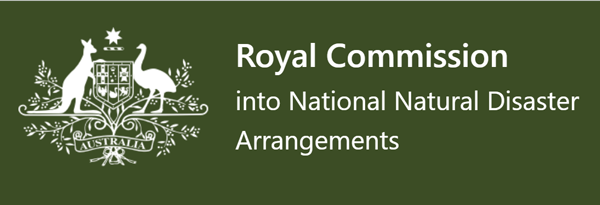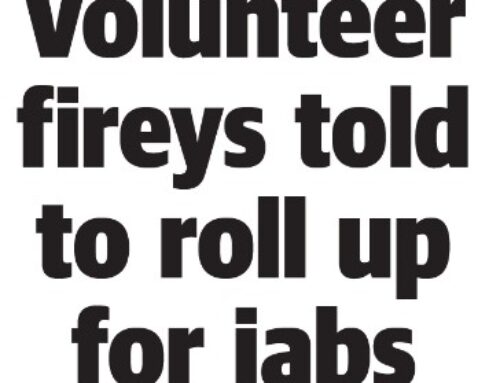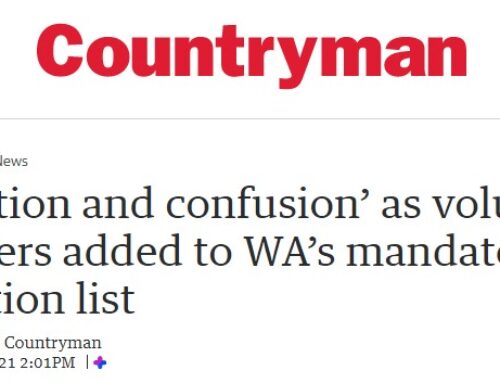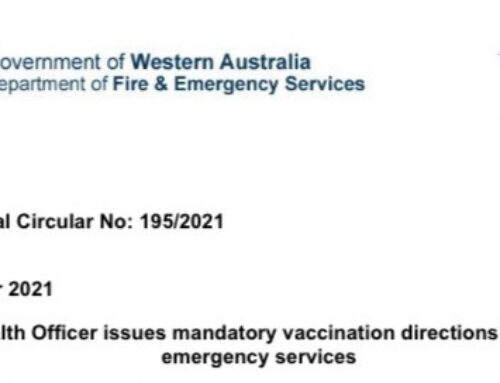Air Chief Marshal Mark Binskin AC (Retd)
The Honourable Dr Annabelle Bennett AC SC
Professor Andrew Macintosh
Royal Commission into Natural Disaster Arrangements
Locked Bag 2000
MANUKA ACT 2603
Dear Commissioners
FORMAL SUBMISSION TO THE ROYAL COMMISSION
Firstly, please allow me to put on the record our appreciation to Commissioner Binskin for taking the time to accompany me on a tour of some local areas of interest during the Royal Commission’s visit to Western Australia on Friday 13 March 2020. Your strong and genuine interest in the broader, long term issues facing our members and their communities was very reassuring and deeply valued.
ABOUT US
Bushfire Volunteers is the trading name of the 29-year old Association of Volunteer Bushfire Brigades WA Inc (AVBFB), the registered Charity and peak body for Western Australia’s 560+ Bush Fire Brigades and the 20,000+ volunteers they encompass. Although it has come with significant consequences for the organisation and some of its spokespeople, the association has always advocated without fear or favour for appropriate respect, resourcing and recognition of bush fire volunteers across the state.
The AVBFB was a founding member (and maintains its membership) of what is now the Council of Australian Volunteer Fire Associations Inc (CAVFA) and has unsuccessfully applied for membership of the Australian Fire and Emergency Services Council (AFAC) in an effort to correct the long-standing anomaly of WA’s largest fire and emergency service having no representation within that organisation.
IMPORTANT BACKGROUND
While there are certainly similarities to some Rural/Country Fire Services in other Australian States, the Western Australian Bush Fire Service is thoroughly unique in that the “ownership”, resourcing and operation of each Brigade is the legal responsibility of its respective Local Government.
Legislation enables the State Government Department of Fire and Emergency Services (DFES) to take control of Bush Fire Service resources in certain emergency circumstances, but in WA, the largest fire and emergency service is actually a network of many locally “owned” and managed, independent services. To be clear, despite the recent creation of a Rural Fire Division (RFD), Western Australia does not have a State Government Rural/Country Fire Service with operational responsibilities nor capacity.
Although this unique situation creates some challenges, it also delivers a number of extraordinary opportunities to build and empower strong, resilient local communities – particularly in regional and remote areas where the risk of catastrophic wildfire is often at its highest.
Unfortunately, the lived experience of many of the AVBFB’s most experienced and skilled emergency services personnel is that in general, Western Australia has not made good use of those opportunities. Indeed, the association asserts that largely due to what can only be described as ‘political factors’, the actions of successive governments have actually decreased the ability for some local communities to truly self-determine – and there are valuable insights that experience can bring to a number of challenges facing Australia as a nation.
Before we proceed to those detailed insights, it is critical to note that the background above is not intended to be a partisan criticism. Rather, it is acknowledgement that seemingly irrespective of the ideology of the government of the day, fire and emergency services policy has relatively recently become a slave to two masters: the longstanding necessity to allocate resources based on actual need; and the much newer and far more nebulous demands of voters who perceive a need, whether real or not.
THE NEED FOR A ROYAL COMMISSION
When the possibility of this Royal Commission was first mooted, there was significant public commentary in opposition. One of the most cited reasons to not progress was the claim that there had been a number (which varied) of previous formal inquiries into major bushfires and the community would get better value for money if the government simply re-read those reports and ensured all previous recommendations had been implemented.
The AVBFB publicly rebuked those arguments and supported the need for a Royal Commission on the following basis:
- There had never been a Commonwealth Royal Commission into national bushfire issues of preparedness and response,
- If there is a genuine opportunity to extract more value than had already been taken from reports from previous inquiries, there is a need to understand why the recommendations of reports from previous, publicly funded inquiries had not been fully considered, and
- Given the apparent links between the effects of Climate Change and the various major fires during the summer of 2019/20, it is important to establish a Royal Commission now that can consider all relevant history in the context of the most recent Climate Change science.
POLITICS IS THE NEWEST (AND BIGGEST) BUSHFIRE RISK
While continued public funding for scientific research and operational resources will undoubtedly improve outcomes in fire and emergency services, the AVBFB holds the considered view that governments will achieve a much higher return on investment for effort expended on ‘de-politicising’ the portfolio.
It goes to the issue at hand that the AVBFB feels the need to re-state that it is a non-partisan organisation and the observation above is based on broad experiences with all political parties and independent Member of Parliament.
Of equal importance is the association’s willingness to acknowledge that many of the political factors now prevalent in fire and emergency services policy have evolved through a lack of political action as opposed to pro-active partisan agenda or ideology.
For example, one of the consequences of the enormous growth of instant, unfettered digital media is that in recent years, the general public has – for the first time in history – been exposed to terrifying vision from the front-line of many catastrophic bush fires – sometimes in real time. Understandably, this new level of awareness of the immense force of uncontrolled bush fire has created significant fear among the voting public which, in turn, has been translated into electoral support for political aspirants promising greater focus on the prevention of and response to bush fire. Quite properly, those successfully elected to Parliament then seek to deliver their pre-election commitments – with funding being the most commonly used indicator of completion.
Given the obvious voter backlash any government would suffer if it was seen to be reducing emergency services funding, the inevitable outcome is that the “cost” of new promises are added rather than reallocated from existing initiatives as often occurs in other less politically sensitive portfolios.
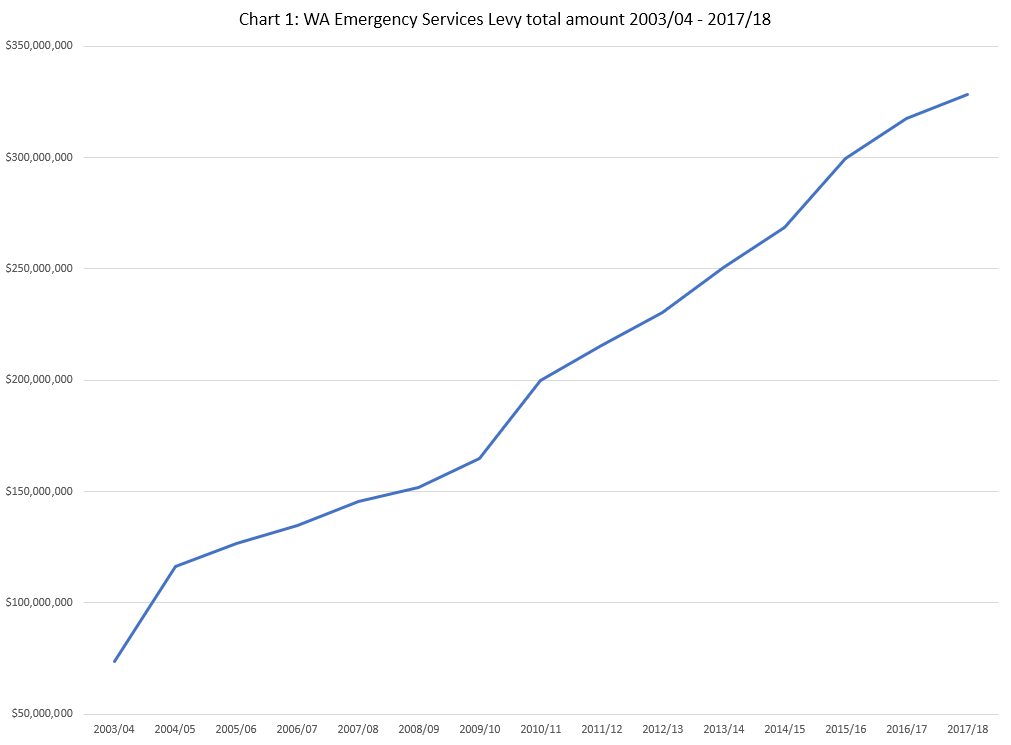 Chart 1 (above) plots the growth of the total amount collected via the levy specifically collected to fund emergency services in Western Australia and demonstrates the assertion above with an almost linear increase to the total DFES budget over a 15-year period.
Chart 1 (above) plots the growth of the total amount collected via the levy specifically collected to fund emergency services in Western Australia and demonstrates the assertion above with an almost linear increase to the total DFES budget over a 15-year period.
As annual departmental budgets grow, so too do the expectations and demands of its stakeholders and inevitably, scrutiny from media and other agencies ‘competing’ for funding. When new priorities appear, governments are forced to consider funding its response by either increasing taxes or reallocating existing expenditure. This puts pressure on Ministers and departments – who have often fought hard to secure funding for their portfolios – to explain the value of their existing budget allocations not only to their constituents but also to the parliamentary colleagues who are actively looking for money that could be reallocated to their own portfolios and electorates.
The result is often a procession of Ministerial media events – cutting ribbons, turning sods and launching new trucks and boats – accompanied with the message “look at all the good work being done here, your tax dollars are delivering lots of real improvements and we therefore can’t reduce this department’s very important budget.”
At its core, this process is started by unreasonable and/or ill-informed expectations of elected representatives and maintains its momentum when those representatives do not act to break what frequently becomes a neat self-fulfilling cycle. It certainly is not unique to any political Party or ideology. And in the most part, it is tolerated by voters as a relatively minor compromise of our broader system of popularly elected government.
However, the AVBFB argues the urgent need for proactive intervention to ensure this process of “politicisation” does not continue to grow with specific regard to the funding of emergency services. The resourcing of Australia’s emergency services must be based purely on an empirical and completely transparent evaluation of actual risk. When a perception is created that resources have been allocated to tick a box in response to community fears, the credibility of our emergency services – and ironically, community confidence – is irreversibly compromised.
REPRESENTATION OF AND RESPECT FOR EMERGENCY SERVICE VOLUNTEERS
NOTE: The AVBFB acknowledges the Terms of Reference do not explicitly mention volunteers but asserts the information below is directly relevant to points a., b., c. and therefore, d. in the Our Letters Patent.
It is universally accepted, yet rarely spoken understanding that the physical size and population distribution of Australia is such that no government will ever be able to justify a paid workforce large enough to provide a minimum level of emergency service response, let alone prevention, preparedness and recovery. Hence, it will always be critical to the nation’s interest to recruit, support and develop fire and emergency services volunteers.
In light of this plain and simple fact, it is nothing short of bewildering that governments (Federal and State) continue to grossly under-invest in processes to engage with and consult this critical component of our essential services.
The AVBFB urges the Royal Commission to investigate and quantify government investment in both bureaucratic and independent representation of volunteers and compare the apparent policy impacts of advice received from representatives of career (paid) personnel.
UNDERSTANDING THE VOLUNTEER EFFORT
NOTE: The AVBFB acknowledges the Terms of Reference do not explicitly mention volunteers but asserts the information below is directly relevant to points a., b., c. and therefore, d. in the Our Letters Patent.
Like its counterparts in other States, the AVBFB has long advocated for greater consultation with and respect for the knowledge and wisdom of local emergency service volunteers with frustratingly poor outcomes.
Evidently, there are many contributing factors to the apparent ease with which many government officers overlook (and sometimes avoid) views of volunteers, especially when they are contrary to prevailing opinion.
Given the growing role of politics in emergency service resource allocation and policy development (explained above), one significant limitation to the support for independent representation of volunteers is the lack of accurate data regarding the quantity and type of work being undertaken by volunteers. As explored previously, Members of Parliament are necessarily reactive to community demands, which are often based more on fearful perceptions than considered reality. Likewise, the lack of ability to substantiate the value of local volunteer effort sometimes means elected leaders will not have the confidence to challenge unreasonable or ill-informed demands from special interest groups and the broader community.
While still in its infancy, the AVBFB has sought to address this issue by creating a new app for mobile devices designed to enable volunteers to easily log the duration, location and type of volunteering they do while contributing to anonymised service-wide statistics to better inform discussion and debate on the true value of unpaid service (https://esvolunteers.org.au/). The app can also provide evidence for volunteer health-related and loss of income claims, as well as provide direct access to discounts and offers being made by businesses that seek a mechanism to recognise the work of our unpaid service personnel.
Unfortunately, requests for government collaboration, funding and public support remain unrequited.
The AVBFB urges the Royal Commission to consider the impact of emergency service policy and resource allocations being made almost exclusively by paid government officers and how governments could improve the support for greater genuine representation of the volunteers who overwhelmingly comprise the majority of human resources by number.
ENSURING LONG TERM SUSTAINABILITY
NOTE: The AVBFB acknowledges the Terms of Reference do not explicitly mention volunteers but asserts the information below is directly relevant to points a., b., c. and therefore, d. in the Our Letters Patent.
As discussed above, it is universally accepted that in order to provide affordable resources to ensure Australian communities are adequately prepared for, capable of responding to, and have the capacity for resilience to, and recovery from, natural disasters, Australian governments will always depend on emergency service volunteers.
However, international trends attributed to changing attitudes, smaller families and reduced opportunity for young adults in rural areas suggest the number of people willing and available to commit to volunteering will steadily decline into the future.
While some of the variables that impact on volunteer recruitment and retention are part of global cultural changes and therefore not within the control of Australian governments, there are others that can and should be addressed.
In November 2019, the AVBFB Committee of Management developed and published the following policy statements regarding compensation of volunteers:
- The association does not support government incentives to individuals based on time spent volunteering.
- The association strongly encourages all levels of government to remove all disincentives to emergency services volunteering.
In essence, the policy recognises that for many, performing their duties as an emergency services volunteer creates significant costs for individuals, their families and employers, however the vast majority of them do not want to be “paid” to do it. As fire and emergency services volunteers responding to emergencies are in fact providing what is an essential service of government, the AVBFB’s view is that unlike volunteering at a sporting club or other non-essential service, it is a responsibility of government to ensure emergency service volunteers do not incur any personal loss for their work.
A practical example of how this policy applies relates to Prime Minister Scott Morrison’s announcement of a temporary scheme to pay emergency service volunteers a daily fee for prolonged service at an incident. In the lead up to the March meeting of COAG where longer term arrangements were to be discussed, the association made representation to Premier Mark McGowan to propose an alternative program. The AVBFB’s preference is a scheme that reimburses employers for ordinary wages paid to employees who were absent from work due to emergency services volunteering. This would ensure neither volunteers nor their employers suffer loss (are effectively penalised) for enabling the provision of the essential service as well as remove any potential for perceived conflicts of interest among the individuals donating their time.
Since Australia (at Local, State and Federal levels) will always need emergency service volunteers and the number of willing and able volunteers is generally declining across the world, it is logical to predict a future that requires an exponential increase in recurrent government spending to fill the gaps with paid firefighters. The AVBFB therefore strongly urges the Royal Commission to consider this a likely major obstacle to maintaining the level of personnel required to enable interstate sharing of this resource and make recommendations for governments at all levels to urgently review and remove as many disincentives to volunteer in emergency services as possible.
LOCAL RESILIENCE, NATIONAL SURGE CAPACITY
NOTE: The AVBFB acknowledges the Terms of Reference do not explicitly mention volunteers but asserts the information below is directly relevant to points a., b., c. and therefore, d. in the Our Letters Patent.
A critical element of Australia’s preparedness for, response to, resilience to, and recovery from, natural disasters is ensuring it has an adequately skilled, resourced and available workforce distributed in such a way that enables the fastest possible initial response with the capacity to draw longer term backup from regions of lower risk. In this way, the physical size and population distribution of Australia is somewhat of an advantage – that is, it is unlikely that the whole continent will ever be at high risk of the same acute natural hazard simultaneously.
As previously discussed, it is universally accepted that in order to provide affordable resources to ensure Australian communities are adequately prepared for, capable of responding to, and have the capacity for resilience to, and recovery from, natural disasters, Australian governments will always depend on emergency service volunteers.
The central premise of those who routinely lobby for more government spending on paid personnel is that response times are kept to a minimum by paying firefighters to be present “on station” 24/7. While certain conditions in industrial agreements make it a lot more complex than a simple “lower turnout time = better outcomes” equation, the association accepts that one of the factors that change outcomes is the time it takes for first responders to arrive at an emergency incident.
However, partly because of the significantly higher raw costs and partly because of industrial issues, the creation of one new career fire station inevitably reduces many more volunteer brigades. Even when only two volunteer brigades are displaced by one new career station, the region suffers a loss of the number of points of origin per km2. Thus, any advantage gained by paying emergency services personnel to be on station while waiting for a callout is quickly diminished if the crews have to drive further to an incident than volunteers based at a closer brigade that doesn’t exist because of the career station.
Indeed, the association argues that one of the genuine strengths of Western Australia’s network of many relatively small, specialised volunteer emergency service brigades and units supporting and supported by career brigades in most highly populated towns is the sheer number of points of dispatch. Although a specialist bush fire brigade may not have the equipment to be the ideal first responder to a structure fire, the crews often put the resources they have and their general emergency service experience to good use by slowing the spread of the fire and providing detailed advice to better prepare more specialist teams travelling from further away. Likewise, a specialist car crash rescue team may not have the 4wd capacity required to fully extinguish a roadside bush fire but may be able to slow the fire’s growth from the tarmac while waiting for a specialist off-road appliance.
Solid investment of both money and culture in volunteer emergency services not only enables this many-node network approach to rapid response but also delivers other less obvious benefits. These include more areas – especially smaller regional towns – that have the year-round (to help with preparedness and prevention, not just response) benefit of trained residents and perhaps most importantly, increases the number of skilled and available personnel that can be deployed to relieve local personnel at major incidents in other parts of the country. This “surge capacity” is explained very well in a short animated video published by our peers at Volunteer Fire Brigades Victoria (https://youtu.be/cRcDE6d3ljw).
The association urges the Royal Commission to incorporate the multitude of benefits of emergency services models that enable more trained personnel in more locations in its considerations and recommendations regarding the adequacy of emergency response across the country and particularly for interstate surge capacity.
THE UNITED FIREFIGHTERS UNION (UFU)
NOTE: The AVBFB acknowledges the Terms of Reference do not explicitly mention non-government organisations but asserts the information below is directly relevant to points a., b., c. and therefore, d. in the Our Letters Patent.
In our trademark “frank and fearless” manner, we note without malice that similar growth in the emergency services budgets of other Australian states has unequivocally coincided with increased public and private (sometimes militant) advocacy from the United Firefighters Union (UFU).
Being acutely aware of the realities of being partially government funded, the AVBFB again notes that the statement above is not intended to be partisan or critical of either the UFU or any government. It is, however, the AVBFB’s genuine attempt to draw the Royal Commission’s attention to an issue that many would (privately) agree has long been an “elephant in the room” with regard to Australia’s preparation for and response to bushfires and other natural disasters.
It would be disingenuous to portray the association as being without agenda, but equally so to pretend that the United Firefighters Union doesn’t also have a legal and moral obligation to advocate exclusively in the interests of its members. Without commenting on the worthiness of either, the association makes the important point that while both organisations have obligations to represent the interests of defined interest groups, the UFU membership in WA is around 1,200 and the AVBFB aims to reflect a much broader cross-section of the community that also has nothing personal to gain for its outcomes.
The association has always argued for the benefit of whole communities, maintaining a central theme of the need for government policy to encourage widespread, independent resilience – that is, communities that are skilled, resourced, supported and confident to prepare for, respond to and recover from adversity. The AVBFB does not believe that the UFU as a whole or among individual members has any agenda to act contrary to the community’s interest but notes the inescapable conflict of interest it has in the specific matter of developing true community resilience. As both the Union and its members have a direct personal interest in greater demand for efficient response to emergencies at all cost, it would be simply ignoring the elephant in the room to not consider advice from the career sector without accepting that it benefits from a philosophy of “reliance” as opposed to “resilience” as is the well-demonstrated preference of the volunteer sector.
Thus, the AVBFB urges the Royal Commission to investigate and consider the historical, current and future role and influence of the United Firefighters Union in the development of emergency services policy and resource allocation.
THE AUSTRALASIAN FIRE AND EMERGENCY SERVICE AUTHORITIES COUNCIL LTD (AFAC)
NOTE: The AVBFB acknowledges the Terms of Reference do not explicitly mention non-government organisations but asserts the information below is directly relevant to points a., b., c. and therefore, d. in the Our Letters Patent.
Although the AVBFB generally supports the existence and work of the Australasian Fire and Emergency Service Authorities Council (AFAC), it maintains two long-held significant concerns:
1. While a perception has been created that AFAC voting members represent every emergency service in Australia, WA’s largest emergency service – the Volunteer Bush Fire Service, is not represented. When the AVBFB applied for membership to correct this anomaly, it was rejected on the premise that the State Government Department of Fire and Emergency Services (DFES) pays an annual membership and is deemed to be the representative for the service, despite having no legislative connection to the 20,000+ volunteers in our service.
This is problematic because a number of policies that directly impact Western Australian Bush Fire volunteers have their genesis within AFAC and are adopted by State and Territory Governments on the misinformed premise that representatives of all career and volunteer emergency services were represented at the decision-making table.
Even though in practice there are relatively few areas of conflict, the larger and much more problematic issue is the apparent confirmation that direct volunteer input is neither valued or even wanted by what is effectively a quasi-government agency (see below). The AVBFB believes this to be symptomatic of a significantly larger and more impactful issue of key stakeholder mismanagement that provides great opportunity for improvement in the coordination between the Commonwealth, State, Territory and local Governments relating to the preparedness for, response to, resilience to, and recovery from, natural disasters.
It therefore urges the Royal Commission to consider the historical, current and future role, responsibilities and impact of AFAC in the national approach to emergency management and accountability.
2. For the record, the AVBFB again states its general support for the existence and work of the Australasian Fire and Emergency Service Authorities Council (AFAC).
However, given AFAC is a private company and its membership is limited to government agencies that pay annual membership fees (presumably funded by government fire and emergency service budgets), the AVBFB asserts that it is a quasi-government agency, not dissimilar to a sub-committee of COAG.
While it is not uncommon for government agencies to participate in external stakeholder associations, AFAC is problematically different to most because its members (only government agencies) set agendas and make policy decisions that many of the individual members who set those agendas and voted on policy decisions (government agencies) then embrace as stakeholder-endorsed policy recommendations.
For example, when a Member of the Western Australian Parliament asked a question about what work was being done to substantiate the risks of bush fire fighters contracting cancer from their work, the public servant responding to the Estimates and Financial Operations Subcommittee as the witness representing a government department that is a voting member of AFAC said:
“AFAC and the Bushfire CRC also have a number of national forums looking into things such as personal protective equipment for bush fire fighters…”
Another more recent example is in the response Prime Minister Scott Morrison provided Federal Parliament in answer to a Question Without Notice from the Member for Clarke, Andrew Wilkie about the adequacy of Australia’s aerial firefighting fleet, in which Mr Morrision said:
“The government takes its advice on the matters that you’ve raised from the Australasian Fire and Emergency Service Authorities Council.”
Secondarily, while the AVBFB again feels the need to formally note it is generally supportive of AFAC, it holds a very strong philosophical view that if a government is going to take policy advice from a group that is comprised only of government departments that use tax-payer funds to be part of that group, the deliberations and mechanisms of that group ought to be subject to the same accountability and transparency measures imposed on government departments, including a process akin to Freedom of Information.
It is argued that the status quo creates a deeply problematic perception that either government processes for inter-departmental cooperation are somehow flawed and ineffective or quasi-government committees like this are established, in part at least, to bypass accepted accountability and transparency processes. Clearly either explanation confirms a serious potential obstacle to consultative, credible and accountable cooperation and coordination between all essential stakeholders.
The association therefore urges the Royal Commission to consider the interplay between AFAC and government in terms of the value to tax-payers on issues of national emergencies.
THE COST OF BUREAUCRACY
The association accepts that the combined expenditure of Australian Local, State and Federal governments on fire and emergency services is enormous. Indeed, it has publicly argued that in Western Australia at least, the budgeting process that successive state governments have allowed to evolve has created a number of inefficiencies that if addressed, would enable a sizeable reduction in the amount required to be levied for the portfolio.
Unfortunately, like many bureaucratic institutions, government departments are highly susceptible to the law of diminishing returns i.e. beyond a certain point, every dollar spent delivers fewer actual returns.
Given these two observations, the AVBFB notes that despite constant increases in government expenditure on emergency services in WA, there has not been a relative increase in funding to Local Government volunteer bush fire services. Indeed, as Chart 2 (below) illustrates, despite having around ten times more personnel than any other emergency service in WA, the total amount of State Government funding to the Bush Fire Service has fallen dramatically as a proportion of the amount of hypothecated levy collected.
Again noting the unfortunate likelihood of repercussions for the honest portrayal of our experience, the AVBFB asserts that this phenomenon is neither new or uncommon.
For centuries, human beings have gathered around pots of money (or natural assets), built a castle around it and spent a great deal of time and effort “defending” the wealth from theft and invasion. Similarly, as many experienced political pundits would agree, government agencies – across all portfolios and under the supervision of all persuasions of government – routinely personify this long-held human instinct by fighting for increased budgets every year and investing some of the hard-won resources into protecting the growing empire from raids from outside the castle walls.
Despite being an uncomfortable reality within many large bureaucracies, most government agencies remain functional and indeed, sometimes even prosper from the competitiveness sometimes created by a subtle “us and them” culture between departments. Unfortunately, in the rare case of Fire and Emergency Services that atypically depend not only on the army within, but often more so on hordes of helpers outside of the castle, the age-old formula of lifting the drawbridge and throwing rocks at everyone who approaches is obviously problematic.
Although that analogy may be considered overly dramatic and inflammatory by some, it is intended only to cast light on the issue and express the empathy the AVBFB has for the challenges of governments that remain (and always will) so thoroughly dependant on “outsiders” (i.e. volunteers). Over the years, there have been many attempts to attack us – the association and the individuals it has asked to bring voice to its concerns – for plain and simple observations like this. In this rare opportunity to express genuine, non-partisan concerns and ideas for improvement to Australia’s emergency services, the AVBFB has taken the difficult decision to again approach the drawbridge with the open request for those inside to be a little less paranoid and a little more giving in the resources required to protect not only the Castle, but also the local villages that contain tens of thousands of willing and able helpers, if only they were included, respected and resourced appropriately.
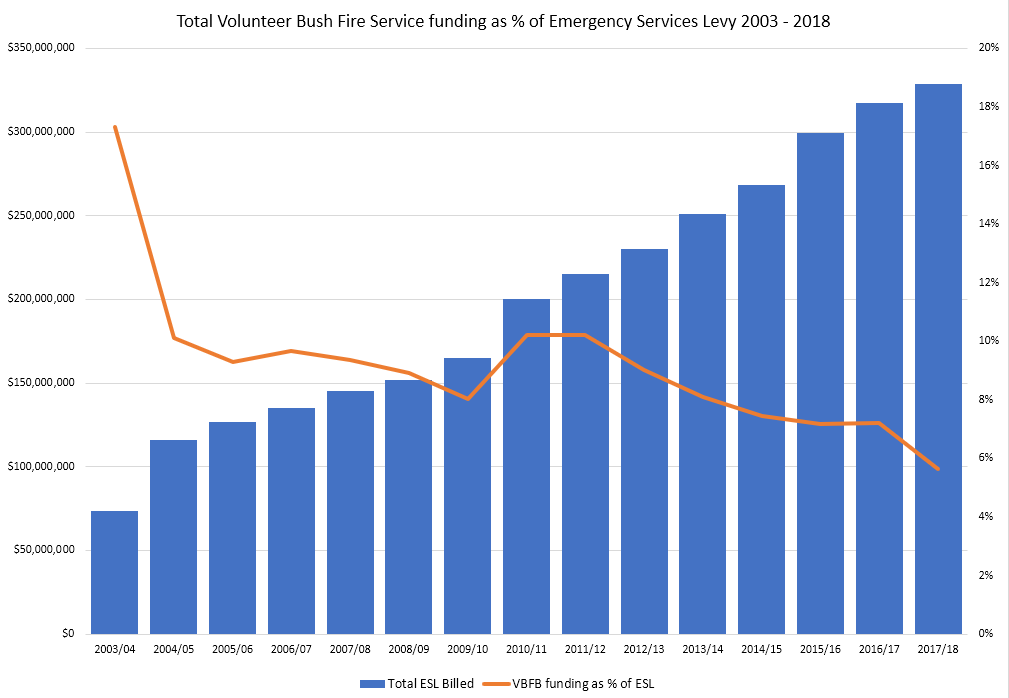 The growth of income to the Castle and relative reduction of support for the surrounding villages as can be seen in Chart 2 above begs the somewhat obvious, yet rarely asked question of where increases in expenditure go?
The growth of income to the Castle and relative reduction of support for the surrounding villages as can be seen in Chart 2 above begs the somewhat obvious, yet rarely asked question of where increases in expenditure go?
Hoping to not over-extend the usefulness of the analogy, as the Castle gets larger and more bureaucratic, it requires more resources for simple upkeep – without even considering proactive or external improvements. As new paint is applied to the Castle walls and malnourished supporters in surrounding villages begin to ask why their taxes aren’t providing even the daily bread, another ugly, yet inherently human cycle begins – that of self-justification.
In the fire and emergency services portfolio, it could be said that this cycle is most often witnessed in the form of expensive marketing and other programs that, whether by conscious design or not, are partially intended to “educate” the external stakeholders of the returns they receive from having a well-funded central bureaucracy to protect them.
Given the broad acknowledgement by bush fire experts that local, well-resourced capacity is a major factor in not only the effectiveness of suppression, but importantly, also the preparedness, prevent of and recovery from natural disasters – i.e. resilience of local communities, the AVBFB strongly asserts the need for a thorough investigation and cost/benefit analysis of state government expenditure in each respective fire and emergency service portfolio.
Doing so will not only create a potential for recommendations that could significantly improve efficiency in each state department, but also take advantage of the unique opportunity created by a rare national Royal Commission to compare with the aim of identifying and sharing the most efficient elements from each jurisdiction.
The association again accepts this suggestion may not be welcomed by all state governments and sadly, incite retaliation, but holds firm on its long-held commitment to advocate without fear or favour in the interests of the unpaid yet highly professional people who are often (and sometimes dangerously) under-resourced on the premise of there being not enough government money available.
The Royal Commission is therefore urged to investigate, or recommend an urgent investigation of, the return on investment all state governments obtain from current and historical expenditure and an analysis of any factors that impact on Australia’s collective capacity to prepare for, be resilient to and recover from natural disasters.
THE ROLE OF THE COMMONWEALTH IN RESPONDING TO NATIONAL EMERGENCIES
The AVBFB supports regulatory changes to ensure the Commonwealth has the power to declare a state of national emergency and have clear authority to take all necessary action when in the national interest.
Obviously the ideal would be for any such action to be taken with the full consultation and support of States and Territories, however, there should be legislative provision for the Commonwealth to act without local support or even consultation when it is necessary to do so in the national interest.
While the association is the most strident advocate for local decision-making, it holds the very clear and well-informed position that there are certain situations that absolutely justify control being taken by an authority with a greater capacity and/or broader strategic considerations. Similarly, the association has strong reservations about the long-term impact of rigid paramilitary styled “command and control” structures on volunteers but openly accepts the need for absolute clarity in relation to responsibilities during an emergency.
It is the considered view of the AVBFB that this represents sound public policy that encourages local community empowerment as well as being consistent with its long-held support for the current Western Australian process of escalating the responsibility for control of incidents based on severity and potential impact.
OPPORTUNITY: IMPROVE EXPERIENTIAL LEARNING AND KNOWLEDGE SHARING
The AVBFB holds the strong view is that there is enormous potential value in thoroughly reviewing significant operational events as soon as possible after the prevailing threat is completely mitigated.
While most State and Territory governments undertake some form of review of most major incidents, the association sees the opportunity for significantly improved outcomes from these types of reviews if they were mandatorily paid for, conducted by, and accountable to, an agency of the Commonwealth rather than each State.
Irrespective of the effort taken to ensure independence and transparency, it is unlikely that any government department undertaking a review of itself with the primary goal of identifying systemic failures for improvement will ever be perceived as being thorough and open. Take, for example this exchange between the Hon Rick Mazza MLC and Western Australia’s last Fire and Emergency Commissioner Wayne Gregson where Mr Gregson was asked to reassure a Parliamentary estimates hearing that a forthcoming major incident review would not be compromised by the Department reviewing itself:
Hon RICK MAZZA: Just on that issue of review, in The Sunday Times last weekend there was an article headed “National expert for probe”, stating that “Commissioner Wayne Gregson will ask a member of the Australasian Fire Authorities Council” to do a peer review. Is that right?
Mr Gregson: It is not quite right. I was asked what my intention was with respect to reviewing Esperance. I said that I would be commissioning an internal review—a major incident review—which is the usual and ordinary course of business, and that I would refer that document to be peer reviewed by a member of AFAC. My intention was to then provide that to the police so that can form an integral part of the coronial inquest file.
Hon RICK MAZZA: Are you a member of AFAC?
Mr Gregson: Yes, I am. Just so you know who the members are, it is a company, a separate entity, but the members are commissioners or chief executive officers of land management agencies or emergency service agencies, so they are my peer commissioners and the chief foresters and members of the state emergency service commissioners.
Hon RICK MAZZA: The article did say that they would conduct an independent peer review.
Mr Gregson: I would not read too much into the article. What I was trying to convey was that once the major incident review was done, I would give it to one of my peer commissioners, perhaps the commissioner for Victoria or another commissioner, and say, “Could you review that major incident review with commissioner’s eyes and tell me if there was anything further that you think has been overlooked or have we inadvertently glossed over issues or is more depth required on certain issues?” because I wanted to present a complete, comprehensive picture to the police for the coroner.
Hon RICK MAZZA: Is any consideration being given to a full inquiry, like a Keelty inquiry, into the Esperance fires?
Mr Gregson: They are externally imposed on me as a department.
Changes to Australia’s legal framework to enable this would likely result in many enhancements in natural disaster risk management, preparedness, resilience and recovery within and between every State and Territory including:
- A consistent methodology in terms of the process of review and reporting standards. This will deliver many valuable benefits including the capacity for comparative research and longitudinal evaluation of improvement across and between States.
- Unprecedented opportunity for learnings from a major incident in one State or Territory to be quickly and easily shared with, and utilised by, all others.
- Significant cost-savings to State and Territory governments. Whether real or merely perceived, there exists a problematic view that the available budget is a factor in the decision to undertake a review of any given incident and if so, the level of independence and thoroughness with which is occurs.
- Eliminate the opportunity for conflicts of interest that arise when a State Government Department undertakes a review of itself.
- A much higher likelihood of transparency and subsequent stakeholder confidence in the published report.
- Increased awareness of contemporary issues in emergency management by the Commonwealth will increase the opportunity for States to advocate for Federal Government funding and regulatory support when issues common to all States are identified.
The association urges the Royal Commission to consider the merits of a recommendation that the Commonwealth, in consultation with COAG and representatives of immediate stakeholders, takes all action necessary to urgently fund the development of a standardised incident review process, create the resources necessary to undertake reviews of major incidents in every State and Territory and publish reports of every review undertaken using a consistent reporting framework.
OPPORTUNITY: NATIONAL TRAINING OVERSIGHT AND COORDINATION
In Western Australia, successive governments have invested heavily in various training initiatives within the Fire and Emergency Services portfolio. Although on the surface this appears to be a very positive achievement, it has resulted in many years of uncertainty and constant change that has at least been an irritant to many busy volunteers.
Of greater frustration and concern, however, is that the training that the state department offers (and continues to develop currently), is not nationally accredited.
Recognising that some volunteers enjoy formal training and seek every opportunity for growth while others volunteer only because there is a need for someone to protect their community and therefore only undertake minimum training, the AVBFB has always advocated for a flexible system that will meet the needs of those two types of volunteers and everyone in between. This is also consistent with the association’s position on the need to remove unnecessary formalities and requirements that end up being viewed by some as disincentives to volunteering.
Just as that flexibility would cater for time-poor volunteers with no personal interest in formal training, the association’s efforts have also consistently sought to ensure that all training provided would align with nationally accredited modules so volunteers who moved states could easily demonstrate prior learning and not be forced to spend more of their time and effort undergoing duplicate training.
In recent years, the importance of training that is accepted by all Australian governments has come to the fore because of the sharp increase in the number of interstate deployments being required. At the same time, CAVFA (the association representing fire and emergency volunteers nationally) has been denied a seat at the table of a national training body that already includes two representatives of career personnel. There may be many explanations given for this anomaly, but yet again without fear or favour, this kind of bias leads to missed opportunities to genuinely share knowledge and insight from a deeply experienced (and absolutely critical) part of the sector, and equally as importantly, a very destructive cultural divide that ultimately becomes a large obstacle in effective and efficient resource sharing in times of genuine emergency.
It therefore the considered view of the AVBFB that the lack of coordination of training across the country represents not only a lost opportunity for efficiency, but more importantly, a strong risk to the long-term viability of sharing of human resources during national emergencies. Hence, the association urges the Royal Commission to consider the potential consequences of the lack of nationally consistent training and make recommendations to encourage, if not mandate, greater universality of training between emergency services and states.
Yours sincerely,
[Association of Volunteer Bush Fire Brigades Inc T/A Bushfire Volunteers]

